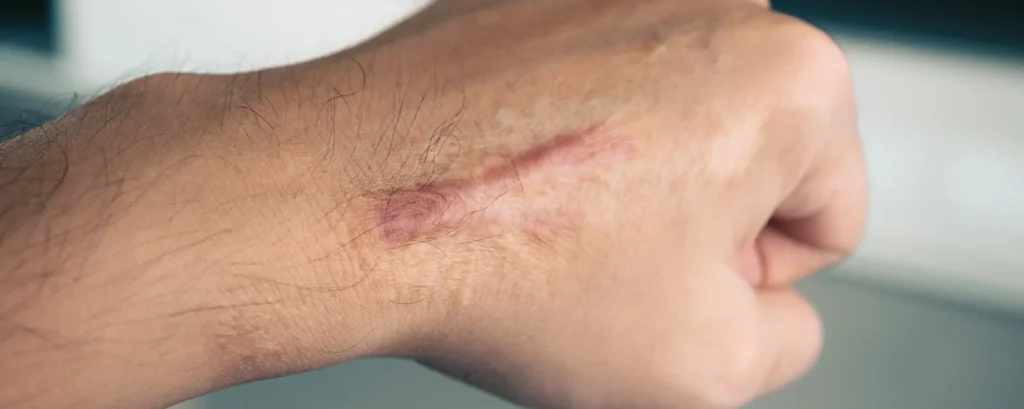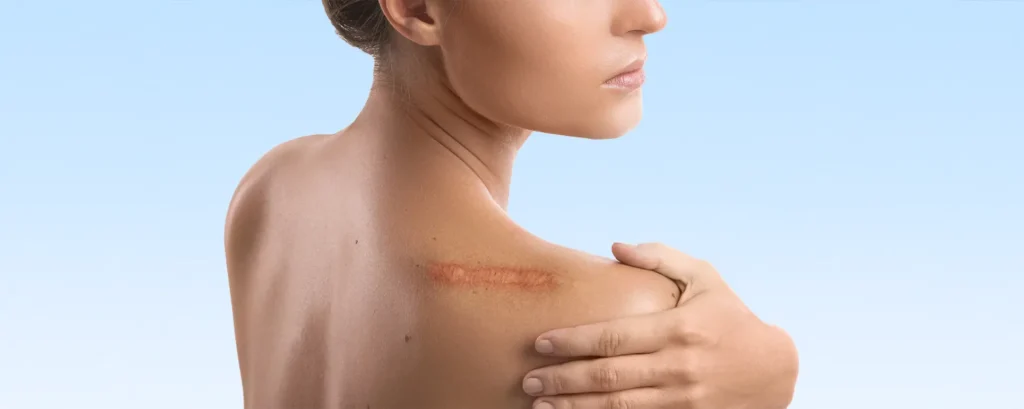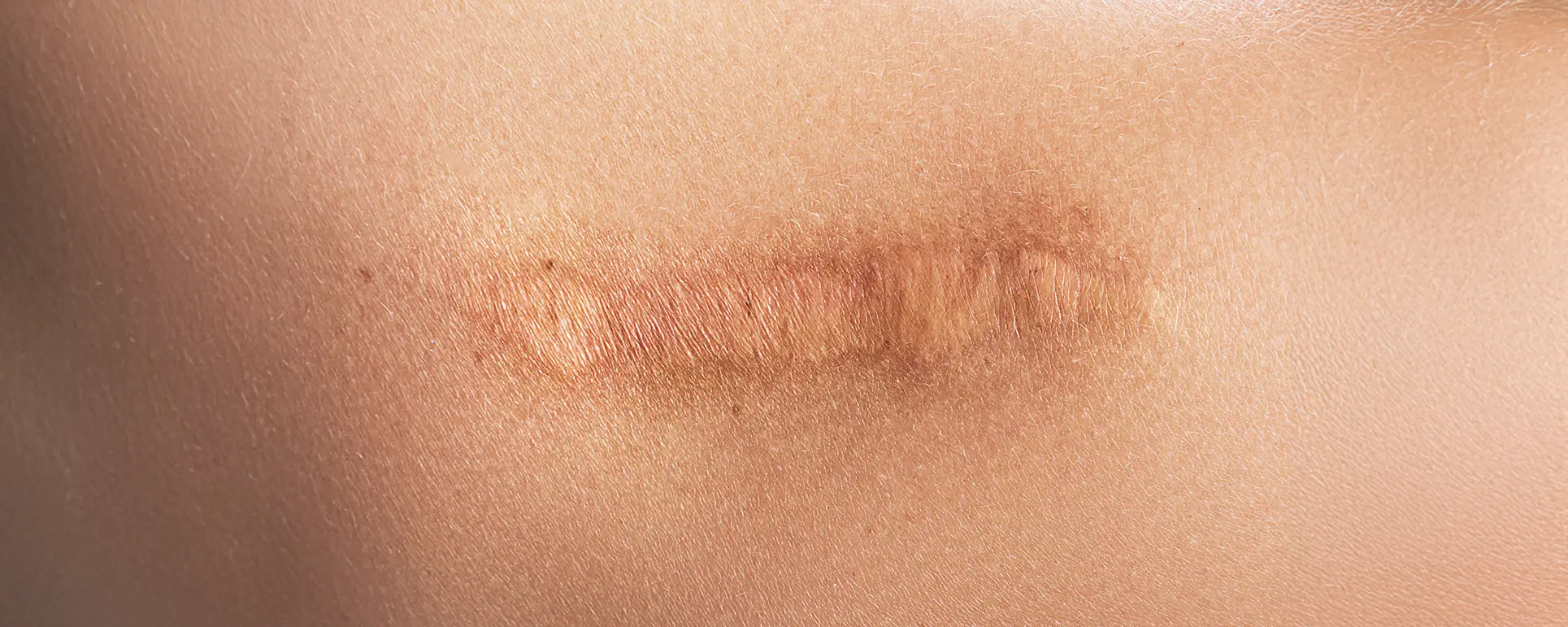Scars are a natural and unavoidable part of the body’s healing process. Whenever the skin is injured whether from a cut, burn, surgery, or acne the body works to repair the damage by producing new collagen fibers. This protective mechanism is essential for closing wounds and preventing infections. However, the way scars eventually look can vary greatly from person to person. Some scars fade over time into smooth, pale marks that blend with the surrounding skin, while others remain raised, red, or thick and can feel rough or uneven.
The reason behind this difference often lies in how much collagen is produced during the healing phase. If the body produces just enough collagen, the scar is more likely to flatten and become less noticeable. But when excess collagen is created, the result can be a raised or bumpy scar, such as a hypertrophic scar or a keloid. Other factors also play a role, including genetics, skin type, the depth and size of the wound, and even where the injury occurs on the body. For instance, scars on areas that experience frequent tension or movement like the chest, shoulders, or knees may be more prone to thickening.
Understanding these variations can help set realistic expectations when it comes to healing. It also highlights why two people with similar injuries may end up with scars that look very different. The good news is that there are a variety of treatments available to minimize raised or visible scars, ranging from silicone sheets and topical gels to steroid injections, microneedling, and laser therapy. While not every scar can be completely erased, many of these options can improve texture, flatten raised tissue, and reduce discoloration, helping scars become less noticeable over time.
Types of Scars

Scars are not all the same, and their appearance can vary greatly depending on how the skin repairs itself after an injury. The healing process is influenced by several factors, such as the depth and size of the wound, the location on the body, the body’s collagen response, age, skin type, and even genetic tendencies. For example, some people may naturally produce more collagen during healing, leading to raised scars, while others may develop scars that appear sunken or flat.
Understanding the different types of scars can help you identify what you may be dealing with and what treatment options might be most effective. Here are the main types of scars you are likely to come across in everyday life:
1. Keloid Scars
Keloid scars are one of the most noticeable and challenging types of scars to deal with. They are characterized by their raised, thick, and enlarged appearance, often extending far beyond the original boundaries of the wound. Unlike normal scars, which usually flatten and fade with time, keloids continue to grow because of the body’s overproduction of collagen during the healing process. This excessive collagen build-up creates a firm, rubbery, and sometimes shiny scar tissue that can be pink, red, or darker than the surrounding skin.
Keloid scars often develop in people who have a genetic predisposition to abnormal scarring. Research shows they are more common among individuals with darker skin tones, although they can appear in anyone. They may form after a variety of skin injuries such as surgical incisions, acne breakouts, chickenpox, burns, vaccinations, piercings, tattoos, or even small cuts and insect bites. In some cases, keloids may take weeks or months to develop after the initial injury, and once formed, they can continue to grow slowly over time.
While keloids are usually harmless from a medical standpoint, they can cause physical discomfort such as itching, tenderness, or pain, especially if they are located on areas that experience friction with clothing or movement, like the chest, shoulders, or earlobes. Beyond the physical effects, keloid scars can also lead to emotional or psychological concerns, as their prominent appearance can make individuals self-conscious about their skin.
Treating keloid scars can be difficult, and there is no single guaranteed method of removal. Common approaches include corticosteroid injections to reduce inflammation, silicone gel sheets to flatten the scar, cryotherapy (freezing), laser treatments, or pressure dressings. In some cases, surgical removal may be attempted, though there is a risk that the keloid may return larger than before. Because of this, doctors often recommend a combination of treatments and long-term management strategies rather than relying on one solution.
Overall, keloid scars are a result of the body’s natural healing response going into “overdrive.” While they are not dangerous, they can be both physically uncomfortable and cosmetically concerning, making awareness and early treatment important for those prone to developing them.
Key Takeaways about Keloid Scars:
- Raised, thick, and extend beyond the original wound
- Caused by excess collagen production during healing
- More common in people with genetic predisposition or darker skin
- May develop after acne, burns, piercings, tattoos, or even small cuts
- Can cause itching, tenderness, or discomfort
- Difficult to treat and may return after removal
- Treatments include steroid injections, silicone sheets, cryotherapy, laser therapy, and surgery
2. Hypertrophic Scars
Hypertrophic scars are another common type of raised scar, but unlike keloids, they remain confined within the boundaries of the original wound or injury. They are typically firm, thick, and may appear red or darker than the surrounding skin, especially in the early stages of healing. Over time, hypertrophic scars may gradually flatten and fade, particularly with proper care, though in some cases medical treatments may be required to improve their appearance.
These scars are caused by an overproduction of collagen during the wound healing process. When the skin experiences a deep cut, burn, surgical incision, or trauma, the body naturally responds by producing collagen to repair the damaged area. However, when too much collagen builds up in the wound site, it results in a hypertrophic scar. Unlike keloids, these scars do not continue to grow indefinitely and are limited to the injured area.
Hypertrophic scars are more likely to form in areas of the body where the skin is under constant tension or movement, such as the chest, shoulders, knees, and elbows. They are also common following surgical wounds or severe burns. In addition to their raised appearance, they may cause symptoms such as itching, tenderness, or even stiffness if they form over joints.
Treatment options for hypertrophic scars often focus on reducing the excess collagen and improving skin flexibility. Common approaches include silicone gel sheets, corticosteroid injections, laser therapy, pressure therapy, and in some cases minor surgical revision. With the right management, many hypertrophic scars naturally improve and become less noticeable over time, unlike keloids which are more persistent.
Overall, hypertrophic scars are the result of the body’s natural healing process going slightly into “overdrive,” but they usually have a better chance of improving with treatment compared to keloids.
Key Takeaways about Hypertrophic Scars:
- Raised and thick, but stay within the boundaries of the wound
- Caused by excess collagen production during healing
- Often appear red, pink, or darker than surrounding skin initially
- Common after burns, cuts, surgeries, or areas under skin tension
- Can cause itching, tenderness, or stiffness (especially near joints)
- More likely to flatten and fade over time than keloids
- Treatments include silicone sheets, steroid injections, laser therapy, and pressure therapy

3. Atrophic Scars
Atrophic scars are a type of scar that appear as depressed or sunken areas on the skin, creating an uneven surface compared to the surrounding tissue. Unlike raised scars, which result from excess collagen production, atrophic scars form when the body produces too little collagen during the healing process. This lack of structural support leads to visible indentations that can vary in size, shape, and depth.
These scars are especially common after skin conditions that damage deeper layers of tissue, such as severe acne breakouts or chickenpox. In both cases, the infection or inflammation destroys healthy skin cells and the underlying support structures. Because the body is unable to fully replace the lost tissue, the result is a hollowed or pitted scar. Atrophic scars can also develop after trauma, surgery, or other injuries where tissue loss occurs.
Dermatologists classify atrophic scars into three main subtypes, each with its own appearance:
- Ice Pick Scars – These are narrow but deep scars that look like small punctures in the skin. They are often very difficult to treat because of their depth.
- Boxcar Scars – These are wider depressions with sharply defined edges, resembling the marks left by chickenpox. They can be shallow or deep and are easier to notice under bright light.
- Rolling Scars – These scars are broad and shallow with sloping edges, giving the skin a wave-like or uneven texture. They often make the skin look less smooth overall.
Atrophic scars are most noticeable on the face, particularly the cheeks, temples, and forehead, though they can appear anywhere on the body. For many people, their presence can affect self-confidence, since facial scars are hard to conceal and may even influence social or professional interactions.
Unlike some raised scars, atrophic scars rarely fade significantly on their own. However, advances in dermatology and cosmetic treatments provide a range of options to reduce their appearance. Non-invasive treatments like chemical peels, microdermabrasion, and microneedling help stimulate collagen production and encourage skin renewal. Minimally invasive procedures such as dermal fillers can temporarily lift sunken areas to match the surrounding skin. More advanced treatments include laser resurfacing, subcision (a minor surgical procedure that releases fibrous scar tissue), and platelet-rich plasma (PRP) therapy, all of which promote new collagen growth and smoother skin.
Ultimately, atrophic scars reflect the opposite problem of keloid or hypertrophic scars: instead of producing too much collagen, the body produces too little. This imbalance in the healing process leaves lasting marks, but with the right treatment approach, their visibility can be significantly reduced, restoring a smoother and more even skin texture.
Key Takeaways about Atrophic Scars:
- Depressed or sunken scars that form below the skin’s surface
- Result from insufficient collagen production and loss of underlying tissue
- Commonly caused by severe acne, chickenpox, or trauma
- Classified into three main subtypes: ice pick, boxcar, and rolling scars
- Often appear on the face, which can affect self-esteem and confidence
- Rarely fade on their own and usually require treatment for improvement
- Treatments include chemical peels, microneedling, dermal fillers, laser resurfacing, subcision, and PRP therapy
Factors Affecting Scar Healing

Scar formation is a natural part of the body’s healing process, but not all scars heal in the same way. The appearance, size, and texture of a scar depend on a combination of internal and external factors that influence how the skin repairs itself. While some people may develop thin, faint scars that fade over time, others may form thick, raised, or sunken scars due to differences in biology, lifestyle, or the nature of the injury. Understanding these factors can help explain why scars vary so much from person to person and can also guide treatment and prevention strategies.
Key Factors That Influence Scar Healing:
- Skin Type and Genetics – Genetics play a major role in scar formation. Some individuals are naturally more prone to developing keloid or hypertrophic scars because their bodies produce excess collagen during healing. People with darker skin tones are at a higher risk of keloids, while others may heal with flatter, less visible scars.
- Location of Injury – The part of the body where the injury occurs greatly affects how the scar heals. Areas that experience frequent stretching, movement, or pressure such as the chest, shoulders, knees, or back are more likely to develop raised scars due to skin tension. In contrast, scars on areas with thinner skin may appear flatter or more subtle.
- Depth and Size of Wound – The deeper or larger the injury, the more likely it is to leave a noticeable scar. Small surface scratches may heal without a trace, but deep cuts, burns, or surgical incisions often damage multiple layers of skin, making scar tissue formation more prominent.
- Infection or Delayed Healing – If a wound becomes infected or takes longer to heal, the body’s normal repair process is disrupted. This can result in a more pronounced scar, irregular texture, or discoloration. Proper wound care, such as keeping the area clean and covered, reduces this risk.
- Age and Overall Health – Younger people tend to produce more collagen, which can lead to thicker scars. On the other hand, older skin generally heals more slowly and may produce thinner, less raised scars. Overall health also plays a role conditions such as diabetes, poor circulation, or nutrient deficiencies can slow healing and worsen scar appearance.
- Lifestyle Factors – Habits such as smoking, poor diet, or lack of hydration can impair the body’s ability to heal efficiently. Conversely, proper nutrition, hydration, and avoiding sun exposure on fresh scars can improve healing outcomes.
Dermatologist-Recommended Treatments
The right treatment for a scar depends largely on its type, size, location, and how it affects your skin. Since every scar heals differently, dermatologists often recommend a tailored approach, sometimes combining more than one method to achieve the best results. Treatments can improve the appearance of scars, reduce discomfort, and in some cases, restore flexibility to the skin. While home remedies may help with minor marks, professional treatments provide more reliable and noticeable improvements.
Common Dermatologist-Recommended Treatments Include:
- Silicone Sheets and Gels – Silicone-based products are widely used to flatten and soften raised scars such as keloids and hypertrophic scars. When applied consistently, silicone helps hydrate the scar tissue, reduce redness, and improve flexibility. They are often recommended as a first-line, non-invasive treatment.
- Corticosteroid Injections – These are commonly used for keloid and hypertrophic scars to reduce inflammation and slow excess collagen production. Multiple sessions may be needed, and injections can help flatten scars and relieve symptoms such as itching or tenderness.
- Laser Therapy – Dermatologists use different types of lasers depending on the scar. Some lasers resurface the skin to smooth out texture (useful for atrophic scars), while others target pigmentation and redness in raised scars. Laser treatments often require multiple sessions and can be combined with other therapies.
- Microneedling – This technique involves creating controlled micro-injuries in the skin using fine needles. The process stimulates natural collagen and elastin production, which gradually helps fill in depressed scars such as those caused by acne or chickenpox. It can also improve overall skin tone and texture.
- Surgical Revision – In cases of severe or function-limiting scars, surgical procedures may be necessary. Techniques include excising (removing) scar tissue, skin grafting, or rearranging skin with flaps to reduce tightness caused by contracture scars. Surgery is often followed by additional treatments, like silicone therapy or laser sessions, to reduce recurrence.
- Other Advanced Options – In addition to the main treatments, dermatologists may recommend cryotherapy (freezing scar tissue), dermal fillers for atrophic scars, or pressure dressings for burn-related scars. Platelet-rich plasma (PRP) therapy is also being explored for its ability to stimulate natural healing.
Ultimately, consulting a dermatologist ensures that the treatment chosen matches your specific scar type, skin characteristics, and long-term goals. Since no single method works for everyone, a personalized treatment plan often delivers the best outcome.
Final Thought: Taking Control of Your Scar Healing Journey
Scars may be an inevitable part of the body’s healing process, but they don’t have to define your skin permanently. By understanding the different scar types and the factors that influence how they form, you can make more informed decisions about prevention and treatment. Whether you’re dealing with raised keloids, hypertrophic scars, or atrophic marks left behind by acne or injury, there are effective options available to improve both appearance and comfort.
If you’re seeking expert care, you can get in touch with us to book a consultation with one of our scar treatment clinic in London specialists, who can guide you towards the most suitable solution for your skin.
References:
- Limandjaja, G.C., Niessen, F.B., Scheper, R.J. & Gibbs, S., 2021. Hypertrophic scars and keloids: Overview of the evidence and practical guide for differentiating between these abnormal scars. Experimental Dermatology, 30(1), pp.146–161. doi:10.1111/exd.14121. https://pubmed.ncbi.nlm.nih.gov/33009748/
- Ogawa, R., 2017. Keloid and hypertrophic scars are the result of chronic inflammation in the reticular dermis. International Journal of Molecular Sciences, 18(3), p.606. https://www.mdpi.com/1422-0067/18/3/606
- Niessen, F.B., Spauwen, P.H.M., Schalkwijk, J. & Kon, M., 1999. On the nature of hypertrophic scars and keloids: a review. Plastic and Reconstructive Surgery, 104(5), pp.1435–1458. https://journals.lww.com/plasreconsurg/Abstract/1999/10000/On_the_Nature_of_Hypertrophic_Scars_and_Keloids__A.1.aspx
- Lee, Y.I. & Kim, J.Y.S., 2020. Current approaches to the management of keloids: a review. Annals of Plastic Surgery, 84(2), pp.215–221. https://journals.lww.com/annalsplasticsurgery/Fulltext/2020/02000/Current_Approaches_to_the_Management_of_Keloids__A.16.aspx
- Ud-Din, S. & Bayat, A., 2014. New insights on keloids, hypertrophic scars, and striae. Dermatologic Clinics, 32(2), pp.193–209. https://pubmed.ncbi.nlm.nih.gov/24680006/
